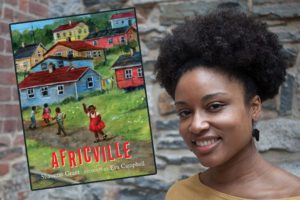shauntay grant
It was a gorgeous day on the grounds of the Africville Museum yesterday for the launch of Shauntay Grant’s new children’s book Africville co-hosted by the museum and Prismatic Arts Festival.
The book began as a poem that Grant first wrote on these grounds, the former site of the community of Africville, as part of a writing workshop she taught where she brought students to different environments to foster their inspiration and creativity. The book centres on a young girl who visits the site of Africville and her imagination, buoyed up by the stories she has heard from her family, conjures up and takes her back, to the rich, colourful and joyful images of home.
As she worked on turning the poem into a book for young children Grant consulted with numerous members of the community, those who had lived and grown up in Africville prior to its destruction by the City of Halifax between 1967, when their church was demolished in secret overnight, and 1970 when the last home in the community was torn down. The focus of the book is not on the loss of Africville, but on the happy sights, sounds, smells and feelings that have been passed down to a child who didn’t know the community in a tangible way like her parents/grandparents/ancestors did, but for whom the community lives on in the stories. This, in itself, is an act of triumph.
Grant’s poetry is brought to beautiful life by illustrations by Eva Campbell, who worked from photographs and consultations with community members, to capture the bright colours and fun adventures of children playing in a small town where they were nurtured, encouraged to play outside in nature, and develop strong bonds of family and friendship with one another and were treated to delicious desserts like blueberry duff.
Africville is currently the first and only book about Africville for this age group: children from 4-7 years old. So much of the history of Africville has been written by white people, and as Irvine Carvery reminded me yesterday, a lot of the history that has been recorded by others, some of which persists to this day, is inaccurate. It’s important that the first book offered to children in Nova Scotia (and beyond) about Africville be one that is grounded in the facts and the experiences of people who grew up and had familial connections there. There is a page of history at the end of Grant’s book, to help give older readers context for the story.
I’m embarrassed to admit that yesterday was my first time visiting the former site of Africville. The grounds of the Africville Museum, a replica of the Seaview African United Baptist Church that was destroyed, are connected to a park, which were the grounds of the community of homes along the Bedford Basin. Even today, within the infrastructure of the city’s highways ferrying traffic to and from the suburbs and the bridge, the museum and park are tucked away between the port, the A. Murray MacKay bridge, and the railway tracks, so it’s possible to live in Halifax for decades and not even entirely understand the logistics of getting there. It’s obvious this is a lasting remnant of both the systematic and deliberate isolation that the City of Halifax imposed on this community throughout its more than 150 years of existence and the appropriation of Africville’s land for the city’s own use. As I stood on the shore of the Basin looking at the gorgeous green trees in the park, I couldn’t help but imagine what this land must have been like in 1870 for some of its earliest residents.
The City of Halifax deliberately tried to sabotage the happiness and prosperity of the residents of this town because the government officials and those who elected them were racist. The government accepted the municipal taxes that Africville’s residents paid, but failed to provide the community with running water, sewers, paved roads or police, fire-truck and ambulance services. At different points in its history the city put all of its least desirable institutions within Africville’s vicinity, including a slaughterhouse, the city jail, a hospital for infectious disease, and even the city garbage dump.
Yet, Grant captures beautifully the power and resilience of the spirit of the people who lived there, of those who have worked steadfastly since to rebuild the relationships, connections and histories that were lost after the razing of their community, and how that spirit has been passed on to the next and future generations. It’s empowering, inspiring and beautiful.
Africville by Shauntay Grant is available online HERE, and is being sold at the Africville Museum (5795 Africville Road, K’jipuktuk (Halifax)). If you haven’t been to the Museum before, I recommend you go.
Click HERE to find out about the other shows and events happening this week at Prismatic.
Follow Prismatic on Facebook. Twitter. Instagram (@PrismaticArts)






 World Theatre Day: My God Is It Ever The Time to Invest in Canadian Plays
World Theatre Day: My God Is It Ever The Time to Invest in Canadian Plays 